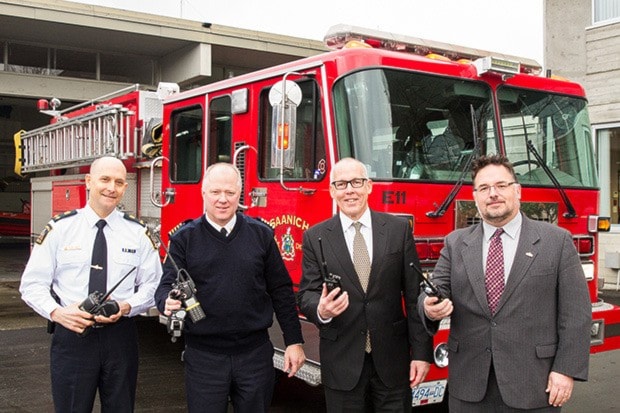Emergency service agencies in Saanich and the Capital Region will be getting a major boost to their radio communication systems, thanks to a new agreement between Capital Region Emergency Service Telecommunications and Motorola Solutions Canada.
On Monday, the board of directors from CREST announced a $13.1-million investment to upgrade current radio systems across 50 emergency response agencies – including Saanich Police, Saanich Fire and B.C. Ambulance Service – as they collectively move to the 700 MHz frequency band with Project 25, the preferred suite of standards for digital emergency radio communications in North America.
“We’re going to a radio spectrum that, I believe, is going to be far more reliable on a global scale, especially in areas like the downtown core with buildings,” said Saanich Police Deputy Chief Scott Green. “You’re going to have better coverage, better reliability, better building penetration and so forth, which means greater safety.”
The five-year plan will see the conversion of existing radio sites to P25, as well as new transmitters and receivers and better radios for first responders. The new technology is part of a $24.4 million upgrade approved in 2014.
By upgrading the networks, CREST general manager Gordon Horth said emergency crews will experience better audio clarity, improved coverage, fewer dropped calls and less interference, in addition to the benefits of increased capacity, noise suppression and data encryption. The upgrades are scheduled to run from early 2017 through 2018 in three phrases, starting with Greater Victoria’s urban core, followed by the Saanich Peninsula and West Shore, and ending with the Gulf Islands and out towards Sooke.
While Saanich Police are already on a digital platform, Horth said Saanich Fire is currently on an analog system, and putting them both on the same network will solve a variety of interoperability issues. Additionally, he said that E-Comm, which covers emergency services in the Lower Mainland and Fraser Valley, is in the process of switching to the same P25 system, meaning emergency crews on the Island and the mainland will be able to more easily communicate.
“By having a shared platform, we have the ability for users to roam between the two areas seamlessly and be able to work without interruption across that common boundary,” said Horth. “If we lost our master site here, the brains of the operation, E-Comm could back us up, and vice versa.”
Horth referenced the recent Kelowna wildfires, in which emergency crews from outside the Okanagan went up to provide additional help.
“They had different platforms and different crews couldn’t communicate with one another,” said Horth. “This basically negates the possibility of that happening.”
Coincidentally, Horth said the U.S. is also moving to 700 MHz frequency, with a Motorola platform in King County and along the border, allowing for opportunities for B.C. emergency services to better communicate with Washington state crews in such cases as earthquakes.
jacob.zinn@saanichnews.com
